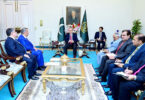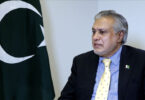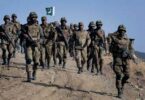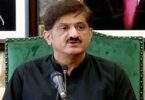Air Marshal Farhat Hussain Khan, HI(M), SBt (Retd)
The design and development of a fighter aircraft is a cutting-edge niche capability exclusive to a few nations. The philosophy behind the JF-17 project was to develop a lightweight, single-engine, multi-role combat aircraft that could replace PAF’s ageing fighter fleet while fulfilling the dynamic requirements of an evolving battlespace and also propel the nation on the road to self-reliance and thereby, hedge against geo-political tectonics.
The JF-17 project is a cross-industry collaboration in design, development and production spanning over three decades. China National Aero-Technology Import & Export Corporation (CATIC) and Pakistan Aeronautical Complex (PAC) are the primary drivers behind the co-development and co-production of the aircraft. Pakistan Air Force exercised the most intimate interface across the project by extending its expertise, test pilots and engineers; securing the unique position of being one of the few air forces of the world involved in co-designing, co-developing and co-producing a fighter aircraft of the highest international standards.
The continuous evolution of the project has seen the fielding of three variants which speaks of the immense potential of the aircraft. The JF-17 Block 1 was the first version followed by, Block 2 with air-to-air refuelling capability, enhanced weapons and avionics. Decades of experience in maintaining and operating Western aircraft immensely contributed to iteratively refining the design of JF-17 aircraft; ultimately leading to its latest version.
The JF-17 block 3, also hailed as a Gen 4+ platform, is the most advanced version with additional hardpoints, more sophisticated weapons and integrated modular avionics including an Active Electronically Scanned Array (AESA) radar, an Internal EW suite, Helmet mounted display (HMD) and excellent Man-Machine-Interface (MMI) with the WMMC (Weapon Mission Management Computer) forming the heart of the processing architecture.
The AESA radar has the advantage of higher resolution, longer range, faster scanning, lower probability of detection and greater jamming resistance while the integrated EW suite allows effective mission execution in a highly contested environment. Options for mating with legacy western avionics and sub-systems are also retained.
The JF-17 can perform various roles in different scenarios. In Counter Air Operations, the aircraft can engage adversary aircraft using its BVRAAM for long-range interceptions and advanced Imaging Infrared missiles in dogfight mode. The aircraft possesses excellent SEAD / DEAD capability and can also employ satellite, inertial, optical and laser-guided bombs for day/night precision engagement in surface attack roles.
The JF-17 can engage enemy ships and naval vessels using its long-range dedicated anti-ship missiles with sea-skimming capability. The JF-17 can also conduct aerial reconnaissance missions using its onboard sensors and equipment, such as the KLJ-7A AESA fire-control radar, the KG-600 electronic warfare suite, and the ASELPOD advanced targeting pod. The data collated from its sensors can be shared and transmitted to other platforms and ground stations using an indigenous high-fidelity data link system for enhanced situational awareness and net-centricity. The aircraft is robust and resilient, with high structural strength translating into advanced aerodynamic performance. The wing leading-edge extension (LEX) and leading-edge flaps (LEF) considerably enhance lift and manoeuvrability at high angles of attack. Quadruplex digital fly-by-wire (FBW) system provides computerized flight controls and reduces the pilot’s workload.
The FBW system also allows the JF-17 to perform high-g manoeuvres and maintain stability at low speeds and high altitudes. The aircraft’s versatility is a testimony to its adaptability, allowing Russian or Chinese origin engines, thereby providing additional flexibility and catering for a wider range of operational requirements. The JF-17 has transformed into the backbone of the PAF’s ready and arrayed fleet with over 140 aircraft in service.
The successful execution of PAF’s ‘QPQ+’ response against India on 27 February 2019, in the post-Pulwama skirmish, has earned JF-17 accolades for a proven battle-tested machine. JF-17 aircraft truly stands out as a maintainable and reliable solution within its budgetary constraints. In a landscape where cost-effectiveness is paramount, the JF-17 shines, offering remarkable value for its capabilities. JF-17 aircraft is ‘custom built’ by PAF (a reputed Air Force of the world) to afford operational choices in the contemporary Air Environment, which is becoming complex and challenging by the day. Due to these outstanding capabilities combined as an affordable and cost-effective package, vis-à-vis its peer competitors, the weapon system is being actively pursued by other nations. It was exported to Nigeria in 2021 and is successfully operated by the Nigerian Air Force.
The reliability and spare supportability of the weapon system are augmented through indigenization, joint partnerships and redundant supply lines. The aircraft enjoys an excellent safety record comparable to any other fourth-generation fighter aircraft and mirrors the high training and professional standards of the PAF. The JF-17 is also constantly being upgraded and improved to enhance its safety features by incorporating modern proactive maintenance practices.
The weapon system is equipped with a maintenance-friendly design, coupled with the ability to proactively troubleshoot errors through Integrated Survivable Radio (ISR), which enhances operational efficiency and minimizes downtime. PAF always strives to employ the most advanced techniques for grooming its human resources. It trains to outwit, outfight and outshoot the enemy.
PAF also conducts joint exercises with other armed forces as well as friendly countries and regularly participates in national and international forums and competitions to showcase its capabilities and achievements. This culture of excellence and innovation, which encourages its personnel to constantly improve their skills and knowledge is continuously honed through institutions and centres of research and development specialising in various aspects of air power. Consequently, the aircraft has performed in the air shows at Zhuhai, Dubai, Farnborough, Paris, Qatar, Bahrain, Saudi Arabia, and the Turkish Centennial Celebrations. The aircraft has also participated in the Shaheen exercises between Pakistan and China, Anatolian Eagle Turkey, Spears of Victory KSA and the Bright Star exercise in Egypt.
The JF-17 project is the quintessential icon of an undertaking that shapes aspirations and has become part of an identity-forming exercise in national endeavour and perseverance. The unconditional success of the JF-17 program follows not only through its operational dividends on the road to self-reliance but also as a symbol of immense pride for the entire nation.
The program has established Pakistan as an important player in the aerospace industry and shall prove to be the kernel for further progress in the field. Air Marshal Farhat Hussain Khan, HI(M), SBt (Retd) is the President of Centre for Aerospace & Security Studies (CASS), Islamabad & is also serving as Advisor on Aviation to the Caretaker Prime Minister of Pakistan. He has served as Chief Project Director (CPD) JF-17 and Chairman Pakistan Aeronautical Complex, Kamra. He can be approached at cass.thinkers@casstt.com







